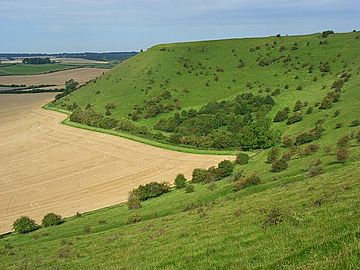White Sheet Hill facts for kids
Quick facts for kids White Sheet Hill |
|
|---|---|
 |
|
| Highest point | |
| Elevation | 245 m (804 ft) |
| Geography | |
| Location | Wiltshire, England |
| OS grid | ST803346 |
| Topo map | OS Landranger |
| Climbing | |
| Easiest route | Public footpaths and bridleways |
White Sheet Hill, also known as Whitesheet Hill, is a famous hill in Wiltshire, England. It's one of the most western areas of "downland" in Britain. Downland means rolling hills made of chalk.
This area is special because its chalky soil helps many rare plants and animals grow. The hill is also home to very old sites, like a Stone Age (Neolithic) camp and burial mounds called barrows. There's also an Iron Age hill fort here.
A Roman road used to run along the hill. This road was once the main path through the ancient Selwood Forest. White Sheet Hill is part of the Stourhead estate and has been looked after by the National Trust since 1946.
The hill is also a special protected area called a Site of Special Scientific Interest (SSSI). It's known as Whitesheet Hill biological SSSI and covers about 136.1 hectares (about 336 acres). It was officially recognized in 1965.
White Sheet Hill is located across three different local areas: Kilmington, Mere, and Stourton with Gasper. It's part of the Cranborne Chase and West Wiltshire Downs Area of Outstanding Natural Beauty. From the top, you can see amazing views across Somerset, Dorset, and Wiltshire.
The White Sheet Radio Flying Club uses the hill for flying model planes. It's a great spot for "slope soaring," which means using the wind that blows up the hill to keep the planes in the air.
Contents
Discovering White Sheet Hill
White Sheet Hill is a fascinating place with a long history. It's not just a beautiful spot for views, but also a window into how people lived thousands of years ago.
Ancient History of the Hill
The hill is home to many ancient sites. You can find about 12 old burial mounds, called barrows, which date back to around 1800 BC. These are places where people were buried a very long time ago.
There's also a large Iron Age hillfort here, known as White Sheet Camp. Hillforts were large settlements or forts built on hills, often surrounded by earthworks for protection.
What Did Early Explorers Find?
In the early 1800s, a man named Sir Richard Hoare, 2nd Baronet explored White Sheet Hill. He was very interested in ancient sites. He wrote about what he found when he dug into some of the burial mounds.
Sir Richard Hoare described how he found old "earthen works" (earth mounds) and barrows right when he started climbing the hill. He noticed that some of the barrows looked like they had been explored before.
In one large barrow, he found that it had once held a skeleton. He also found another barrow that seemed to have two burials. One was of burned bones placed in a simple pot. Above that, there was a skeleton lying down.
Sir Richard Hoare was surprised by this skeleton because its mouth was wide open, which he had never seen before in his explorations.
Images for kids


